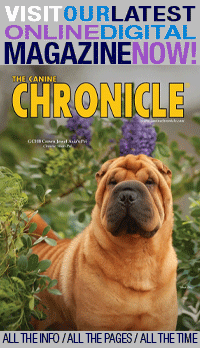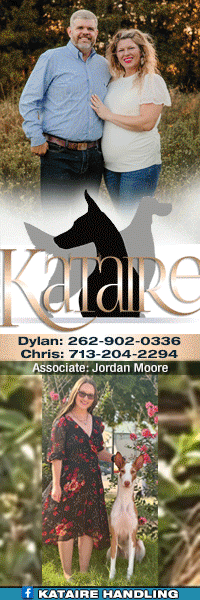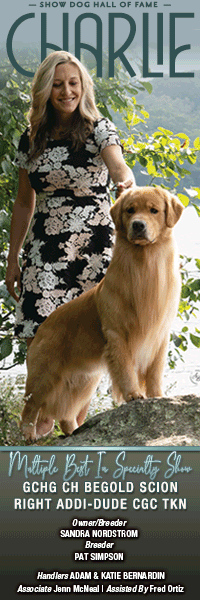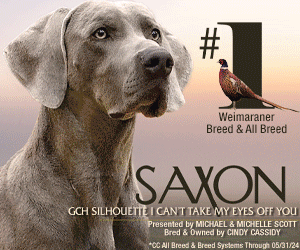Corky Vroom – Never Give Up
by Joan Harrigan
From the archives of The Canine Chronicle, Feb, 2011
It all began with a 10 year-old boy practicing handling techniques in his family’s yard after school. Most junior handlers probably would have focused on their own skills – taking even strides, mastering the smooth transfer of the lead from hand to hand. For Charles “Corky” Vroom, the practice sessions had a deeper purpose. He wanted to understand the dogs – their structure, how they moved, and how their minds worked. Could he make one of his family’s Boxers into a Siberian? A Pointer? These exercises didn’t have a direct application to the show ring – he’d never be asked to make a Boxer move like another breed. However, even as a child, Corky wanted to understand what made a breed unique, so that he could present each to its best advantage.
As with many great dog men, Corky was born into the fancy. His grandmother had bred Pekingese; his father, Henry “Red” Vroom was a handler and the Vroom family bred Boxers and Miniature Pinschers. There was never a question of another career and Vroom apprenticed with successful handler Harry Sangster. With the exception of a tour of duty in the U.S. Navy, dogs were his life’s work.
Sue Vroom, his widow and handling partner, credits Sangster with much more than honing Vroom’s handling skills. “He taught Corky to be a strategist – how to make a dog’s career,” she recalls. “He learned how to campaign – when to travel, when to stay home, when to go to a specific judge.” After Sangster’s death in an automobile accident in 1966, Vroom went out on his own, one of the last of the all-breed handlers licensed by the AKC.
Impressive Statistics…
and Much More
His record in the ring is legendary – many victories at National Specialties and more than 1,000 All-Breed Best In Show (BIS) wins and several thousand Group Ones. He was twice named Fido Dog Handler of the Year and the Kennel Review Dog Handler of the Year. Though BIS at the Garden escaped him, he had seven Westminster Group One wins in five groups – Sporting, Hound, Toy, Working and Herding. Working with clients Gloria and Nat Reese, Vroom brought three dogs to the top of the all breed rankings – the Doberman Ch. Galaxy’s Corry Missile Belle in 1973, the Greyhound Ch. Aroi Talk Of The Blues in 1976 and the Bouvier Ch. Galbraith’s Iron Eyes in 1990. The partnership between the Reeses and Vroom was extraordinary – “Gloria Reese was like a mother to him,” Sue Vroom says. Corky was a great supporter of the Professional Handlers’ Association, serving as its president for five years.
The statistics are impressive, but they don’t reveal how Vroom accomplished what he did. “It’s hard to encapsulate a life that was lived with so much passion,” Sue Vroom says. “He was gifted, brilliantly talented, driven and an intense competitor. He was not, at times, the easiest person!”
Sue Vroom also grew up in dogs, attending shows from the age of four. She first met Corky in the early ‘70s, when he asked handler Walt Schellenbarger to introduce them. In 1980, they met again. Both were divorced. Impulsively, Sue invited him to a barbecue at her home after the Kennel Club of Beverly Hills show. “He never left!” she laughs, and they married in 1982.
They made a formidable team. Based in El Monte, California, Corky planned and supervised the dogs’ conditioning and, “I was in charge of all the hair,” Sue says. “He used to say that if he hadn’t married me, he would have been showing all smooth-coated breeds!”
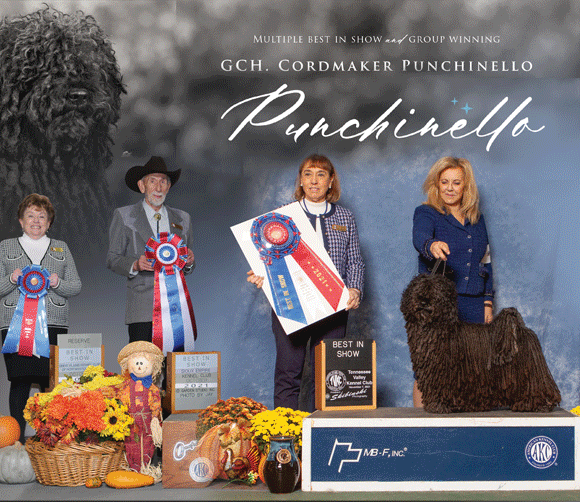
Everyone Has a Chance
Every month, the Vrooms sat down with their assistants and the AKC Gazette to plan the next quarter’s show schedule. “It was never built around a single dog,” Sue states. “We went where it was best for the most dogs, and everybody had a shot. That is the key to keeping clients – they understood that their goals were the same as Corky’s.” Their string generally included class dogs as well as specials; however, it was not uncommon for half the dogs in their truck to be ranked number one in their breeds or groups.
“Corky believed that, at the start of the day, every dog in his truck had a chance to get into the Best In Show ring,” Sue explains. “His goal was to get as many into the groups as possible. If his top dog lost the breed at 9 a.m., he moved on to the next dog at 9:05. Some handlers just focus on the top dog in their truck, and Corky never did. He used to say ‘If I’m beaten with my top dog, that’s just the beginning of the day.’” In addition to handling high profile dogs for clients who could afford to campaign them, the Vrooms showed for many clients with nice dogs that they wanted to finish and bring home as companions. Corky often showed for breeders, who he called “the wind beneath the wings of the sport.” He was rigid in his belief that it was a conflict of interest for professional handlers to breed and show their own dogs.
“Corky used to say that there are really two dog shows – Dog Show A, with breeders and owners who want to finish champions, and Dog Show B, for owners of the top-end specials. Each has different motivations and goals, and Corky understood that,” Sue continues.
While Corky Vroom was a fierce competitor, Sue is emphatic that he never believed in winning at all costs. “For him, it was ‘win for the right reasons,’” she says. “He never did anything to a dog that would insult the intelligence of the judge. The chickens come home to roost when you breed the dog, and it does a disservice to the entire premise of dog shows – evaluating breeding stock.”
Corky’s wins came from his ability to understand a dog and plan and execute a campaign. When he entered the ring, he had an uncanny talent for evaluating the competition and adapting his technique to present his dog to its best advantage against that day’s competition. When a new dog arrived at his kennel, Corky observed him for a week. He’d watch the dog move at liberty before he designed its conditioning program. No dog was fed until Corky had seen it – “he could tell if a Pug were half a pound over or under ideal,” Sue says. There were never more than 20 dogs living with the Vrooms – all specials being actively campaigned. Each was given time in the house as a pet, and Corky often worked on his computer with a half dozen dogs of various breeds at his feet.
Retirement and Reinvention
It was hard when a campaign ended, and a special went home. Often, Corky would have tears in his eyes as he said good-bye. “You understood intellectually that each dog will go home, but every moment while you have him, you invest 100% in the dog, and he invests 100% in you. Corky got into the mind of each dog, and they would do anything for him,” Sue remembers. When a dog retired, its show lead retired with it, and Corky would present the lead to the owner, with the request that it never be used on another dog.
In 2005, Corky retired from handling. The Vrooms considered their options, and decided to relocate to Texas where the AKC had offered Sue a position as an Executive Field Representative. Corky “reinvented” himself as what he’d really always been – a teacher. Many top handlers started as the Vrooms’ assistants and Corky was often approached by junior handlers seeking advice as he sat outside his van after a show. He’d always been free – if sometimes stern – with his advice and handling seminars were the natural progression of his career.
Corky gave seminars throughout the country, as well as classes on popular “K-9 College” cruises. Sue had the chance to observe one of his cruise lectures, and “I was in awe of what he could teach,” she says. Characteristically, his last seminar, in Alaska, was the month before he died. The cancer that had begun in his lungs had spread, and he should not have traveled. He’d committed, however, and Corky would not consider cancelling his trip.
When aggressive treatment was no longer an option, the only way that Sue could get Corky to agree to palliative care was to present it as “alternative treatment.” He was ill for 10 months and fought every step of the way, finally telling his oncologist “you may have given up on me, but I haven’t!” Corky died at home on May 21, surrounded by the people and dogs he loved. He was 68. His best friend and fellow handler, Bruce Schultz, and his wife, Tara, had driven from a show in Northern California to stay with the Vrooms and help Sue with Corky’s care. The Vrooms’ son, Aaron, and daughter-in-law, Lori, were there from California, as well as Sue’s friend Christa Townsend from Kansas City.
Corky’s dogs were on his bed – 13 year-old Tibetan Terrier, Gracie, and the Bouvier, Conner. Gracie wasn’t a show dog – Corky always said she was fulfilling the most important function on the planet by being his friend. Conner, Ch. Vanleighof’s Eyekhan, was the son of the great Iron Eyes, from a frozen semen breeding. Both are with Sue in Texas, and she says that they mourned for Corky just as she did.

A Remembrance
Corky Vroom’s legacy isn’t just his outstanding record of wins. It is the wealth of knowledge that he shared with all who worked with him or asked for help. Jaki Clute of Williamston, South Carolina worked for the Vrooms for three years after she asked for a job when she was 19. “He kept me in dogs,” Clute says. “I was so inspired by what he taught me. He put his whole heart and soul into dogs.” Now handling with her husband, Jamie, Jaki examines each dog before feeding and adjusts the meal accordingly just as Corky taught her.
Tiffany Saxon, another former assistant, is an all-breed handler based in California. Her sentiments echo those of Jaki Clute: “Corky was a passionate man and a man with integrity. He was a great teacher and a legend with a big heart and a strong desire to win. Many others who have been fortunate enough to mentor under him have gone on to become great handlers… Thank you Corky, for being you, teaching us never to quit, always making us laugh and for sharing the passion and inspiring us all to be the best that we can be in this great sport of showing dogs.”
It’s impossible to imagine a finer tribute or legacy.
Short URL: https://caninechronicle.com/?p=45
Comments are closed
